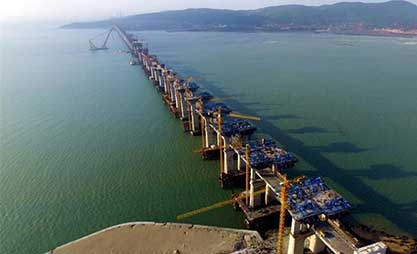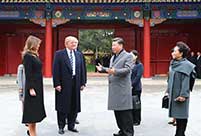

Overall Economic Strength
In 2016, the city recorded the GDP of 1.96 trillion yuan, up 8.2% year on year. The per capita GDP reached over 20,000 US dollars and the annual general budgetary revenue reached 139.38 billion yuan, up 7.2% year on year. The quality and efficiency of the city’s economy had been improved significantly in the meantime, registering a new breakthrough.
The city optimized its industrial structure remarkably, forming 10 hundred-billion yuan level industrial clusters and certifying 370 headquarter enterprises, and the added value of the service industry also reached over 1000 billion yuan. The proportion of the three industries stood at 1.22:30.22:68.56.
Fiscal Revenue & Expenditure
In 2016, the city’s fiscal income grew steadily and healthily, effectively preventing and cracking fiscal and financial risks. The fiscal transparency of the city was also on the top ranks of all Chinese cities. The general budgetary revenue reached 139.38 billion yuan and the general budgetary expenditure was 194.37 billion yuan in the same year.
As far as fiscal expenditure is concerned, the city prioritized the projects to guarantee people’s livelihood as well as key projects, with that for education, social security and employment, medical services and family planning being on the top ranks of expenditure, standing at 32.2 billion yuan, 20.65 billion yuan and 17.39 billion yuan, respectively, reflecting the government’s governance philosophy of guaranteeing people’s livelihood.
State-owned Enterprises
In 2016, state-owned enterprises in Guangzhou (including financial institutions) realized the total operating revenue of 625.14 billion yuan and the total profit of 55.34 billion yuan, with 23.6 billion yuan of state-owned net profit and 55.95 billion yuan of tax. The total assets at the year-end reached 2.7 trillion yuan, with the net state-owned assets of 501.6 billion yuan.
Taxation: In the same year, the city reaped the total local tax and revenue of 251.78 billion yuan, up 11.7% according to comparable prices, of which the third industry contributed nearly 80% of the total tax revenue. The local tax revenue of the city ranked No.1 of all provincial capitals of the nation for the 18th consecutive year. The city also reaped the total state tax of 315.22 billion yuan, up 7.79% year on year.
Private Economy
The city saw a total of 242,146 newly registered domestic market entities in 2016, with the registered captal of 770.255 billion yuan, up 17.61% and 42.5% year on year, respectively. The city’s private economy sector reaped the added value of 782.143 billion yuan, up 8.0% year on year, taking up 39.9% of the city’s GDP. The private investment reached 251.977 billion yuan, up 5.3% year on year, occupying 44.2% of the total fixed assets investment of the city. The city’s private enterprises above the designated scale (with the annual prime operating revenue of over 20 million yuan or above) realized the total industrial output of 499.953 billion yuan, up 7.7% year on year, 1.2 percentage points higher than the average level of the city, taking up 25.6% of the total industrial output of the city’s enterprises above the designated scale.
Fixed Assets Investment
In 2016, Guangzhou put into play the key role of investment in economic operation and adopted a practical and efficient management model for investment. The city finished the fixed assets investment of 570.359 billion yuan, up 8% year on year. The city’s investment projects informationization platform has been launched online, with over 2,000 projects being included in the platform throughout the year, thus gradually realizing the whole-process informationized management of investment projects.
Consumption & Price
In 2016, the city strived to boost new models of consumption including e-commerce, encouraging consumptions on information, tourism and leisure, health and elderly care. It is transforming rapidly from the “Millennium Trade Capital” to the “Modern Trade Capital”. In the same year, the city’s social retail goods totaled 870.65 billion yuan, up 9% year-on-year. The local urban CPI (Consumer Price Index) was up 2.7% year on year, of which food prices were up 4.4%, non-food prices were up 2.3%, consumer goods prices were up 2.7% and service prices were up 2.8%. The prices had been generally kept on a steadily rising level, thus realizing the annual goal of price control.
 Chinese brand becomes largest handset provider in Africa
Chinese brand becomes largest handset provider in Africa Busty Lais Ribeiro steals the Victoria's Secret Fashion Show
Busty Lais Ribeiro steals the Victoria's Secret Fashion Show Highlights Victoria's Secret Fashion Show in Shanghai
Highlights Victoria's Secret Fashion Show in Shanghai China's first cross-sea rail-road bridge takes shape
China's first cross-sea rail-road bridge takes shape A fancy world painted on fallen leaves
A fancy world painted on fallen leaves Photo album: Xi-Trump meeting in Beijing
Photo album: Xi-Trump meeting in Beijing Pitaya flower: blooms for one night, yields delicious fruit
Pitaya flower: blooms for one night, yields delicious fruit Hol Xil: Ideal habitat for Tibetan animals
Hol Xil: Ideal habitat for Tibetan animals Skywalk made of glass opens in Guizhou's Yuntaishan
Skywalk made of glass opens in Guizhou's Yuntaishan Top 10 most sustainable cities in China
Top 10 most sustainable cities in China Top 10 European patent applicants in 2016
Top 10 European patent applicants in 2016 The power of 'She' in China
The power of 'She' in China Seven most beautiful art museums in China
Seven most beautiful art museums in China Cyber rumors must be effectively addressed
Cyber rumors must be effectively addressed
 Migrant workers leave Beijing in droves amid evictions enacted following deadly fire
Migrant workers leave Beijing in droves amid evictions enacted following deadly fire
 Profits before pupils
Profits before pupils
 Is Weibo still the best choice for young Chinese when it comes to social media platforms?
Is Weibo still the best choice for young Chinese when it comes to social media platforms?
Day|Week